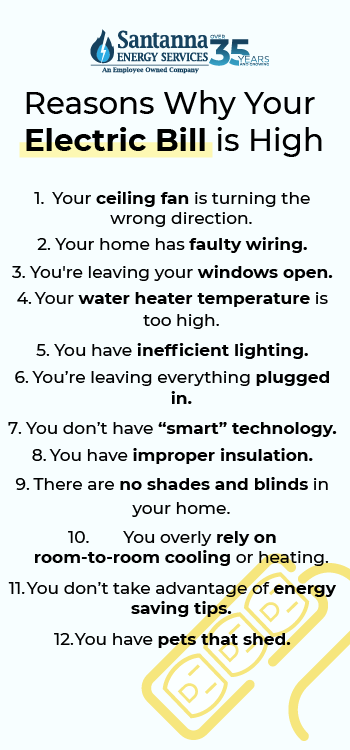How Much Is the Average Electric Bill?
by Tyler Castle
17.3 min read

Curious about how much the average electric bill is? You’re not alone. Whether you’re budgeting for a new home or trying to cut back on expenses, understanding what a typical electric bill looks like can help you stay on track. While costs vary depending on where you live, the size of your home, and how much electricity you use, we’ll break down the national averages and what affects them. Plus, we’ll share tips to help you better manage—and possibly lower—your monthly bill. Let’s dive in!
How Much Is the Average Electric Bill?
According to the U.S. Energy Information Administration (EIA), the average residential electricity price in the US is 16.44 cents per kilowatt-hour (kWh) as of February 2025 with an average monthly consumption of 1000 kWh, leading to an average monthly electric bill to round out at about $164.40.
Keep in mind, your bill can vary based on a multitude of factors, but here are the top three factors to be aware of:
1. Your Location
Where you live significantly affects your electric bill. In the recent 2025 data from the U.S. Energy Information Administration (EIA), residents of Hawaii, Rhode Island, and California, and Connecticut face some of the highest average monthly electricity bills, while those in Idaho, Nebraska, and North Dakota enjoyed some of the lowest. These regional differences stem from a combination of electricity rates, climate, and household consumption patterns which can affect your bill too.
In the same way, each state has different electricity rates. So, if you live in states like New York, Hawaii and California with historically high electricity rates, your average electricity bill could be higher than those across the country even with average electricity usage.
2. Your Home's Size
Larger homes typically require more energy to heat, cool, and power appliances and lighting across more square footage. For example, a 3,000-square-foot home will likely consume more electricity than a 1,000-square-foot apartment, simply because there's more space to maintain and more devices in use. That said, energy efficiency, insulation, and smart usage habits can make a big difference—sometimes even more than square footage alone.
3. Your Energy Consumption
Even in similar sized homes and close locations ultimately, your monthly energy consumption plays the biggest role in your average electric bill. Households that leave lights or electronics on when not in use, run appliances during peak hours, or rely heavily on electric heating or cooling will naturally see higher bills. On the flip side, using energy-efficient appliances, unplugging devices when not in use, and being mindful of consumption—like running full laundry loads or using a programmable thermostat—can significantly reduce your costs over time.
What Other Factors Influence How Much the Average Electric Bill Is?
Aside from the big three above, there's even more factors that affect your average electricity bill. Here are some others you should know:
- Fuel Costs: The type and price of fuel used in electricity generation directly impacts electricity prices. When fuel prices rise, the increased costs are often passed on to consumers, leading to higher electric bills.
- Power Plant Costs: The expenses associated with constructing, maintaining, and operating power plants contribute to electricity pricing thus altering your bill.
- Transmission and Distribution Systems: Delivering electricity from power plants to consumers involves a complex network of transmission and distribution lines. The costs for building, maintaining, and upgrading this infrastructure, especially to enhance reliability and integrate renewable energy sources, are reflected in your electric bill. Additionally, energy losses that occur during transmission can further influence costs.
- Weather Conditions: Extreme weather events, such as heatwaves or cold snaps, can significantly affect electricity demand and supply. Increased use of heating or cooling systems during such periods raises demand, potentially leading to higher prices. Moreover, adverse weather can disrupt power generation and damage infrastructure, resulting in additional costs.
- Regulations: Government policies and regulations at federal, state, and local levels play a crucial role in electricity pricing. Environmental regulations may require utilities to invest in cleaner technologies or purchase emissions allowances, influencing operational costs. Additionally, market structures—whether prices are fully regulated or partially deregulated—affect how rates are set and passed on to consumers.
- Your Energy Market: Whether you reside in a deregulated or regulated energy market also plays a role in electricity pricing. In regulated markets, your local utility company controls both the supply and delivery of electricity, meaning customers have little to no choice in their provider or rate. In deregulated markets, however, consumers can shop around and choose from multiple electricity suppliers, potentially securing lower rates or plans that better match their usage habits while potentially lowering how much their average electric bill is.
How Much is a Typical Electric Bill?
While we've covered how much the average electricity bill is (you can expect a typical electric bill to fall around $164.40), many people still wonder: how much is a typical electric bill for someone like them. Let's look at a few real-life examples to give you a clearer idea:
The typical monthly electric bill can vary widely depending on the size of your household. For example, a single person living in a small home might use around 500 kWh per month, and at an average electricity rate of 15.95 cents per kilowatt-hour, their estimated monthly bill would be about $79.75.
On the flip side, a family with two children in a medium-sized home may consume closer to 1,200 kWh per month, resulting in an electric bill of approximately $191.40 at the same rate of 15.95 cents per kilowatt-hour.
Meanwhile, an extended family living in a larger home with more appliances and higher overall usage could easily use 2,000 kWh monthly, leading to a bill around $319.00 at the same rate.
These examples highlight just how much electricity usage—and therefore monthly bills—can fluctuate based on your living situation. To give you a clearer picture, let's explore a few more hypothetical scenarios that break down what different households across the U.S. might expect for how much their typical electric bill may cost them based on their energy habits, home size, and local rates.
Single Person in Ohio
A single individual living in a small apartment in Ohio might use around 600 kWh per month. At an average rate electricity in Ohio as of February 2025 at 15.85¢ per kWh, their estimated monthly electric bill comes out to about $95.10. Thanks to moderate usage and limited heating or cooling needs, their overall energy costs stay relatively low.
Couple Living in Florida
In Florida, a couple living in a medium-sized home can expect higher electricity usage—especially due to heavy air conditioning use. With monthly consumption around 1,100 kWh and a rate of 14.98¢ per kWh per month as of February 2025, their estimated monthly bill would be about $164.78.
Family of Four in Pennsylvania
A family in Pennsylvania will have higher usage from lighting, appliances, heating, and electronics—especially during cold winters just because they have more people in their home which increases energy consumption. The state's above-average rate also contributes to a higher overall bill. At 1,500 kWh per month and a rate of 18.01¢ per kWh per month as of February 2025, their estimated monthly bill would be about $270.15
Average Electric Bill By Household Type (Based on 16.44 cents per kWh)*
| Household Type | Square Foot Home Size | Monthly Energy Consumption (kWh) | Estimated Monthly Electric Bill | Estimated Yearly Electric Bill
|
| Single Person in Small Home | 800 | 500 | $82.20 | $986.40 |
| Couple with No Kids | 1000 | 850 | $139.74 | $1,676.88 |
| Family with Two Children in Medium Home | 1800 | 1200 | $197.28 | $2,367.36 |
| Extended Family in Large Home | 2500 | 2000 | $328,80 | $3,945.60 |
Note: These consumption figures are hypothetical but align with general trends observed in residential energy usage.
U.S. States With the Highest Electricity Bills
Top 8 States with the Highest Electricity Bills**
| State | Rate (cents/kWh) | Monthly Usage (kWh) | Estimated Monthly Bill | Estimated Yearly Bill |
| Connecticut | 33.25 | 711 | $236.41 | $2,836.92 |
| Hawaii | 42.69 | 537 | $229.25 | $2,751.00 |
| Rhode Island | 31.66 | 594 | $188.06 | $2,256.72 |
| California | 31.66 | 572 | $181.10 | $2,173.20 |
| Alabama | 15.78 | 1145 | $180.68 | $2,168.16 |
| Massachusetts | 30.08 | 577 | $173.56 | $2,082.74 |
| Maryland | 18.32 | 957 | $175.32 | $2,103.84 |
| Florida | 14.98 | 1142 | $171.07 | $2,052.84 |
U.S. States With the Lowest Electricity Bills
Top 8 States with The Lowest Electricity Bills**
| State | Rate (cents/kWh) | Monthly Usage (kWh) | Estimated Monthly Bill | Estimated Yearly Bill |
| Utah | 12.41 | 769 | $95.43 | $1,145.16 |
| New Mexico | 14.61 | 670 | $97.89 | $1,174,68 |
| Montana | 11.62 | 858 | $99.70 | $1,196.40 |
| Wyoming | 11.70 | 869 | $101.67 | $1,220.04 |
| Idaho | 10.95 | 955 | $104.57 | $1,254.84 |
| Iowa | 12.21 | 865 | $105.62 | $1,267.44 |
| Colorado | 15.18 | 711 | $107.93 | $1,295.16 |
| Nebraska | 10.89 | 1013 | $110.32 | $1,323.84 |
Average Electricity Bill in Each U.S. State
How Much is the Average Electricity Bill in Each U.S. State**
| State | Rate (cents/kWh) | Monthly Usage (kWh) | Estimated Monthly Bill | Estimated Yearly Bill |
| Alabama | 15.78 | 1145 | $180.68 | $2,168.16 |
| Alaska | 24.77 | 552 | $136.73 | $1,640.76 |
| Arizona | 15.27 | 1114 | $170.11 | $2,041.32 |
| Arkansas | 11.60 | 1060 | $122.96 | $1,475.52 |
| California | 31.66 | 572 | $181.10 | $2,173.20 |
| Colorado | 15.18 | 711 | $107.93 | $1,295.16 |
| Connecticut | 33.25 | 711 | $236.41 | $2,836.92 |
| Delaware | 15.65 | 932 | $145.86 | $1,750.32 |
| District of Columbia | 19.73 | 704 | $138.90 | $1,666.80 |
| Florida | 14.98 | 1142 | $171.07 | $2,052.84 |
| Georgia | 13.58 | 1081 | $146.80 | $1,761.60 |
| Hawaii | 42.69 | 537 | $229.25 | $2,751.00 |
| Idaho | 10.95 | 955 | $104.57 | $1,254.84 |
| Illinois | 16.49 | 721 | $118.89 | $1,426.68 |
| Indiana | 14.74 | 938 | $138.26 | $1,659.12 |
| Iowa | 12.21 | 865 | $105.62 | $1,267.44 |
| Kansas | 13.62 | 883 | $120.26 | $1,443.12 |
| Kentucky | 13.62 | 1073 | $146.14 | $1,753.68 |
| Louisiana | 13.01 | 1201 | $156.53 | $1,875.00 |
| Maine | 26.26 | 570 | $149.68 | $1,796.16 |
| Maryland | 18.32 | 957 | $175.32 | $2,103.84 |
| Massachusetts | 30.44 | 577 | $173.56 | $2,107.68 |
| Michigan | 18.31 | 676 | $123.78 | $1,485.36 |
| Minnesota | 14.62 | 775 | $113.30 | $1,359.60 |
| Mississippi | 13.23 | 1146 | $151.62 | $1,819.44 |
| Missouri | 11.25 | 1028 | $115.65 | $1,387.80 |
| Montana | 11.62 | 858 | $99.70 | $1,196.40 |
| Nebraska | 10.89 | 1013 | $110.32 | $1,323.84 |
| Nevada | 14.35 | 973 | $139.63 | $1,675.56 |
| New Hampshire | 23.02 | 630 | $145.03 | $1,740.36 |
| New Jersey | 19.70 | 683 | $134.55 | $1,614.60 |
| New Mexico | 14.61 | 670 | $97.89 | $1,174,68 |
| New York | 26.20 | 602 | $157.72 | $1,892.64 |
| North Carolina | 12.47 | 1041 | $129.81 | $1,557.72 |
| North Dakota | 10.20 | 1085 | $110.67 | $1,328.04 |
| Ohio | 15.85 | 873 | $138.37 | $1,660.40 |
| Oklahoma | 11.59 | 1078 | $124.94 | $1,499.28 |
| Oregon | 14.62 | 916 | $133.92 | $1,607.04 |
| Pennsylvania | 18.01 | 846 | $152.36 | $1,828.32 |
| Rhode Island | 33.07 | 594 | $196.44 | $2,357.28 |
| South Carolina | 14.41 | 1081 | $155.77 | $1,869.24 |
| South Dakota | 11.84 | 1037 | $122.78 | $1,473.36 |
| Tennessee | 12.66 | 1168 | $147.87 | $1.774.44 |
| Texas | 14.89 | 1132 | $168.55 | $2,022.60 |
| Utah | 12.41 | 769 | $95.43 | $1,145.16 |
| Vermont | 22.19 | 567 | $125.82 | $1,509.84 |
| Virginia | 14.34 | 1095 | $157.02 | $1,884.24 |
| Washington | 12.48 | 969 | $120.93 | $1,451.16 |
| West Virginia | 14.82 | 1051 | $155.76 | $1,869.12 |
| Wisconsin | 17.48 | 694 | $121.31 | $1,455.72 |
| Wyoming | 11.70 | 869 | $101.67 | $1,220.04 |
What the Average Electric Bill Typically Includes
You’ve seen what affects your total electric bill. Now, let’s break down what’s actually on your bill—what those individual charges mean and where your money goes each month. Each one represents a different aspect of delivering power to your home—and understanding these can help you manage your energy costs more strategically.
Energy supply charges reflect the electricity you actually consume, measured in kilowatt-hours (kWh). This part of the bill is directly influenced by your usage habits and the rate plan you’re on (fixed, variable, unlimited). System loss charges account for electricity lost during transmission and distribution. Utilities often recover these losses by spreading the cost across all consumers.
Delivery charges cover the infrastructure costs of moving electricity from substations to your meter. These include maintenance of power lines, transformers, poles, and emergency services. Customer service fees are administrative charges that cover the cost of maintaining your account—meter reading, billing, service calls, and customer support.
Transmission charges relate to the long-haul transport of electricity from power generation sites to your local grid. This infrastructure is built to meet peak demand, which means homeowners in high-growth or high-usage areas may see increases over time. Though not directly controllable, you can influence grid demand by using power during non-peak hours.
Taxes and surcharges are determined by local, state, and sometimes federal authorities. They might include environmental compliance fees, renewable energy incentives, or public benefit charges. Fuel adjustment charges may also appear on your bill. These account for volatility in the fuel markets and are adjusted monthly or quarterly based on actual generation costs.
Lastly, minimum usage fees and demand charges are less common in residential settings but may apply if your utility charges extra for very low usage (to recover fixed grid costs) or for short bursts of very high demand (common with large electric HVAC systems or EV chargers).
Note that the exact charges on your electricity bill may vary depending on your utility, electric supplier, rate, and additional fees.
How To Calculate Your Estimated Electricity Bill
Calculating how much your average electric bill is easy to do with the right information. To find out how much electricity you’ve used in the past month, start by checking your bill or smart meter. You can also estimate this by tracking the usage of individual appliances and adding them all together to get a rough estimate. For example, a 100-watt bulb used for 10 hours consumes 1 kWh.
Once you’ve found your estimated energy consumption, to get your average electricity bill you’ll need to find your state’s electricity rate per kilowatt-hour. These rates will vary from state to state, and even from supplier to supplier if you’re in a deregulated electricity market. You can usually find this listed on your electricity bill.
For example, if your current rate for electricity is 15.64 cents per kWh and you used 1,000 kWh this month, multiplying 1,000 by your electricity rate will give you an average electricity of $156.40 per month.
For an even more accurate picture of your bill, you can even add the typical extra charges (like delivery charges, taxes and surcharges, etc.) from your bill to your total for an even closer estimate if you have them handy.

Can I Predict What My Energy Bills Will Be?
While it’s not always possible to know your exact electric bill down to the dollar, there are several ways to accurately estimate and anticipate your energy costs—especially if you take the right steps.
One of the most effective ways to make your electricity bills more predictable is by choosing an energy plan with a stable rate, such as a fixed-rate plan, or a consistent supply charge, such as a flat-fee/Unlimited plan. For instance, Santanna’s Unlimited Energy Plan stabilizes the supply charge of your bill each month making budgeting more predictable.*** Fixed-rate energy plans allow you to lock in a fixed rate for the duration of your contract to protect you from huge spikes in energy prices for the duration of your contract.
In addition to picking the right plan, monitoring your energy usage through a smart meter, energy app, or even your monthly bill history can help you recognize patterns and adjust your habits. This kind of tracking gives you a clearer picture of when and how you use the most energy—allowing you to make smarter, more cost-effective decisions year-round.
Why Did My Electric Bill Double?
Even modest rate hikes can lead to higher or potentially doubled bills. As per U.S. Energy Information Administration (EIA) data, in January 2024, the national average residential electricity rate was 15.44 cents per kilowatt-hour (kWh). By January 2025, it had risen to 15.95 cents per kWh—an increase of 3.3% year over year. While this year over year rate charge doesn’t necessarily reflect a “doubled” electricity bill, when combined with seasonal usage spikes, outdated appliances, or changes in household habits, these rate changes can quickly add up leading to a bloated or potentially doubled bill.
Similarly, if your recent electricity usage spiked due to seasonal changes, extra appliance use, or longer hours at home, this can potentially lead to why your electricity bill may have doubled. A common example of this is switching jobs to work from home. When doing so, your bill is most likely to double.
Visitors staying over can lead to more laundry, showers, cooking, and electronic device use—all of which add up inevitably leading to higher than usual bills. On top of this, older devices and systems can become energy hogs over time, drawing more power just to function normally leading to higher bills.
For more possible reasons your bill may have increased, check out the full list here.
Will Computers Raise My Electric Bill?
Yes, computers contribute to your electric bill, especially when used for long hours or left running unnecessarily. Desktops typically consume more power than laptops. A desktop might use around 60-300 watts, while a laptop uses closer to 30-50 watts per hour, making laptops more energy-efficient for everyday tasks.
Extended daily use adds up and can contribute to a higher electric bill. Running a desktop for 8 hours a day can use about 8 kWh per day, costing roughly $38.28/month at a rate of 15.95¢/kWh. Even idle computers use power. Leaving a device in sleep or standby mode still draws electricity, though at reduced levels.
High-performance use increases costs too. Activities like gaming, video editing, or running simulations push the computer to use more energy than basic browsing or office work leading to potentially higher energy bills if you use your computer on a consistent basis.
How To Budget for Your Electric Bill
Budgeting for your electric bill is key to managing your household expenses—especially with rates and usage fluctuating throughout the year. Fortunately, a few smart strategies can help you stay on top of your energy spending and avoid financial surprises.
- Review Your Past Energy Use: Start by examining your electricity bills from the past 6–12 months. Look for seasonal spikes and calculate your average monthly usage. This gives you a clearer idea of what to expect and helps prevent underestimating costs.
- Use Energy More Efficiently: Lowering your usage through energy-efficient appliances, smart thermostats, and better insulation can have a major impact. Even small changes—like unplugging unused electronics—add up over time.
- Create a Utility Reserve Fund: Set aside a little extra each month into a savings fund just for utilities. This gives you a cushion when higher-than-expected bills hit, like during extreme weather months.
- Reevaluate Your Budget Regularly: Your energy use may change when you add new appliances, spend more time at home, or when rates increase. Revisit your budget at least twice a year to make sure it still reflects your real needs.
If you’d rather skip the guesswork and never worry about changes in your supply charge, Santanna’s Unlimited Energy Plan is designed for you. With one flat supply charge every month—regardless of how much energy you use— you get total price predictability and peace of mind, no surprises.*** Check if you’re eligible and lock in a worry-free energy experience today.
How To Lower Your Electric Bill
Here’s how you can lower your monthly costs while keeping your home comfortable and functional:
- Optimize Home Energy Use: Start by identifying where the most energy is being used in your home. Heating and cooling typically account for about 52% of your total energy use. Adjusting thermostat settings, sealing air leaks, and insulating your attic or walls can lead to significant year-round savings.
- Purchase Energy-Efficient Products and Operate Them Wisely: Investing in ENERGY STAR® certified appliances can reduce energy use by 10% compared to standard models. But owning efficient devices isn’t enough—use them intentionally.
- Switch to Energy-Efficient LED Light Bulbs: LED bulbs use at least 75% less energy and last up to 25 times longer than traditional incandescent lighting. Swapping out just a few high-use bulbs can yield noticeable savings—especially in kitchens, bathrooms, and outdoor security lights.
- Reduce “Always-On” Appliances: Also called phantom loads, electronics like TVs, routers, game consoles, and coffee makers continue drawing power even when turned “off.” Use smart power strips or unplug rarely used devices to reduce standby energy use, which can account for 5–10% of your bill.
- Lower the Temperature of Your Water Heater: Most water heaters are factory-set to 140°F, but lowering it to 120°F is more than sufficient for most households—and can save you up to $400 annually, according to the U.S. Department of Energy. This also reduces the risk of scalding and slows mineral buildup in the tank.
- Wash Clothes in Cold Water: Modern detergents work just as well in cold water, so unless you’re sanitizing sheets or heavily soiled items, switching to cold cycles can save you every month.
- Dry Clothes on a Clothesline Instead of Using a Dryer: Electric dryers are among the top energy consumers in a home. Air-drying clothes, especially during warm months, not only reduces electricity usage but also extends the lifespan of your clothing and lowers indoor heat levels.
- Cook with Lids: It might seem small, but cooking with lids on pots can cut cooking times and energy use. It traps heat and steam, allowing food to cook faster while reducing the demand on your stove or cooktop.
FAQs
Which state has the highest electricity bill rate?
Hawaii has the highest average electricity rate in the U.S., at 42.69 cents per kilowatt-hour (kWh) as of February 2025.
Which state has the cheapest electricity rates?
North Dakota offers the lowest average electricity rate, approximately 10.20 cents per kWh as of February 2025.
How much is the monthly average gas bill in the U.S.?
The average monthly natural gas bill in the U.S. ranges between $80 and $100, varying by location, home size, and usage.
Electricity bills don’t have to be a mystery—or a stress point. By understanding how your bill is calculated, what influences energy costs, and how your home uses power, you gain the tools to manage expenses more effectively. Whether your usage goes up due to seasonal shifts, lifestyle changes, or unexpected guests, there are always steps you can take to reduce waste, increase efficiency, and stay in control.
But even with your best efforts, market rate changes and unpredictable demand can still lead to surprise charges.
With Santanna’s Unlimited Energy plan, you’ll get to enjoy a one flat supply charge every month—no matter how much energy you use— you get the stability, predictability, and peace of mind every homeowner deserves.*** No more supply charge hikes when the weather changes. No more guesswork during heavy-use seasons. See if you qualify for our Unlimited Energy Plan today.
*Electricity rate based on the E.I.A’s U.S. rate as of February 2025.
**Electricity rate for each state is pulled from the E.I.A’s most recent rates as of February 2025. The average monthly electricity usage for each state has been pulled from Energybot.
*** Restrictions apply. Enrollment based upon program eligibility. Customers using more than 125% of normal monthly usage as determined by Santanna may be required to switch plans.
Tyler is an experienced energy professional, having worked for Santanna Energy Services, for the past four years. He is passionate about renewable energy and believes that diversifying the energy grid is the key to a sustainable future. Tyler is dedicated to supplying consumers with the best possible energy solutions and works diligently to make sure that Santanna can deliver the highest quality service.







